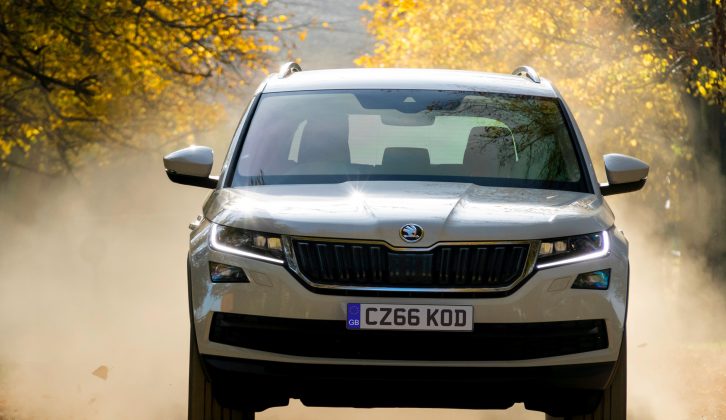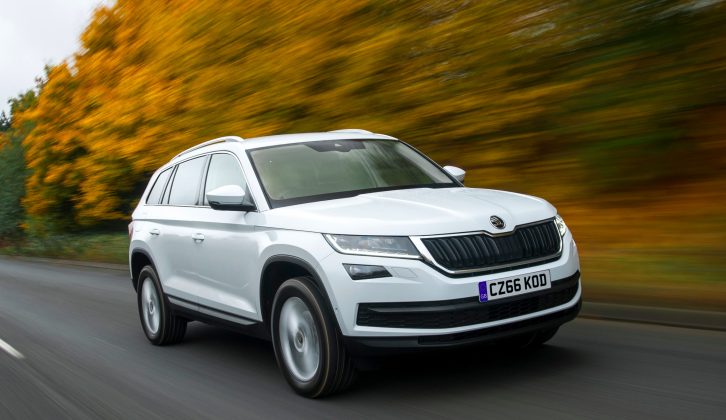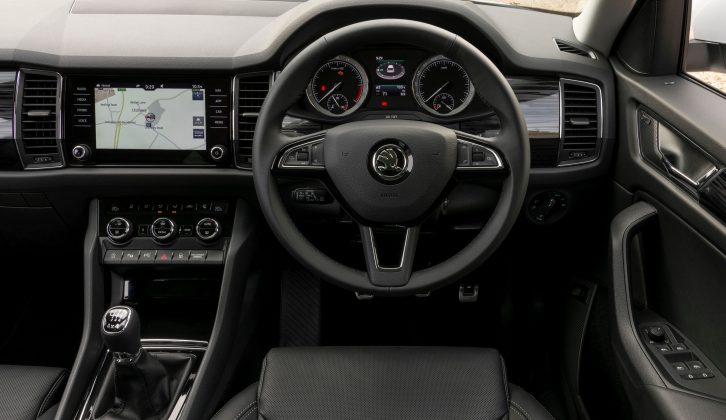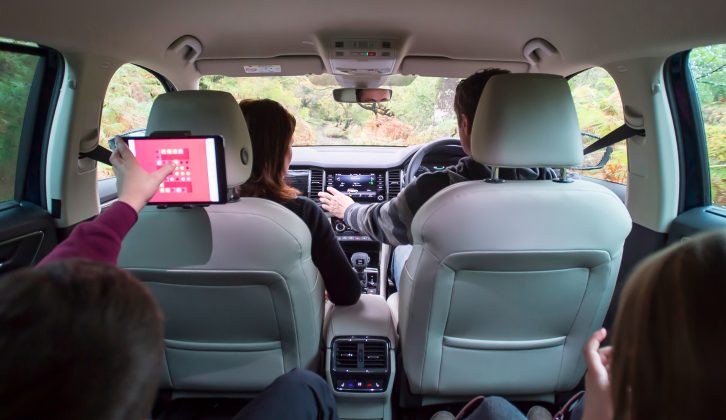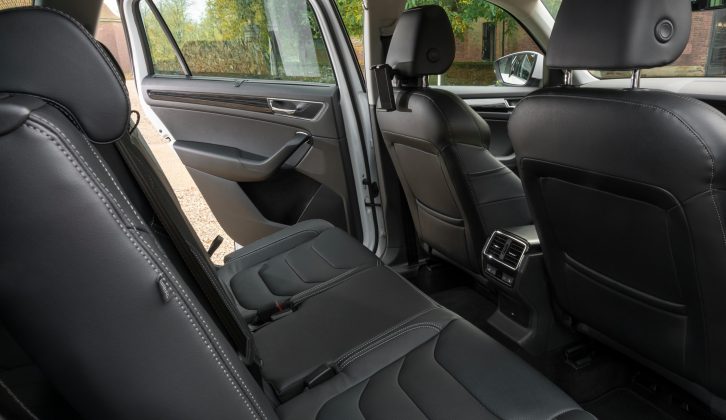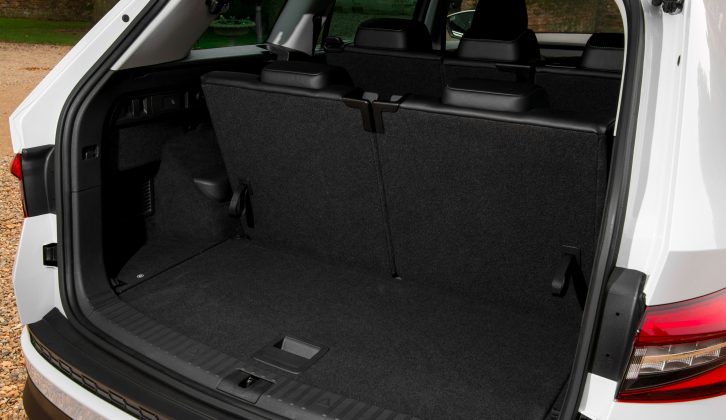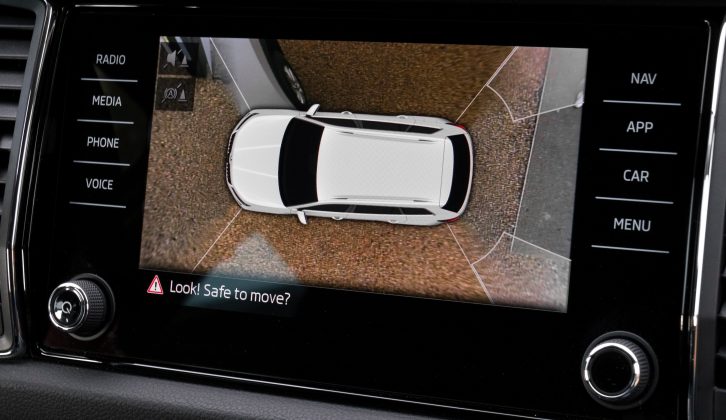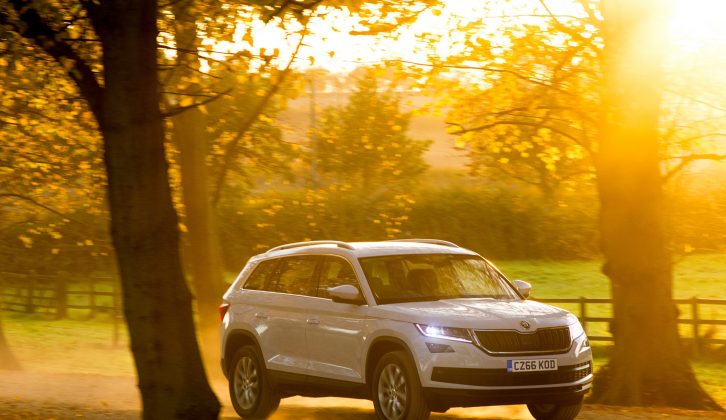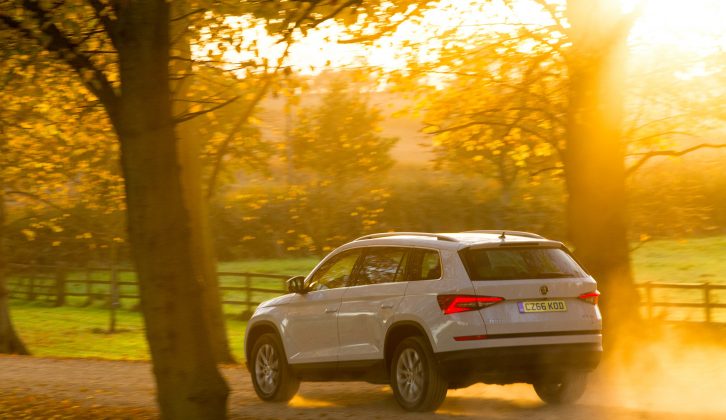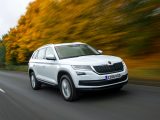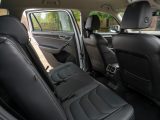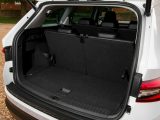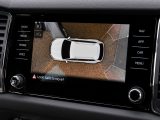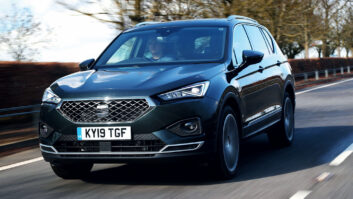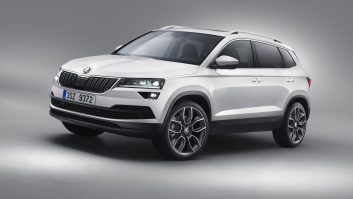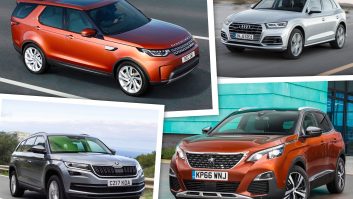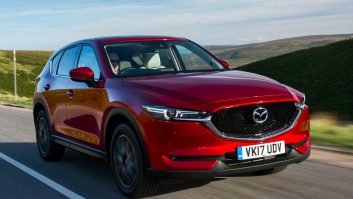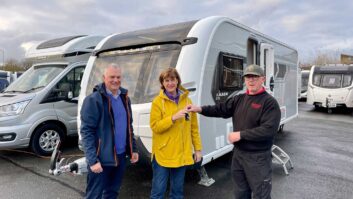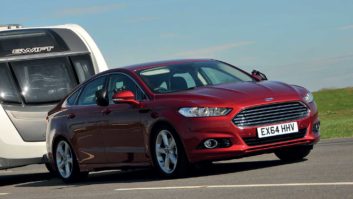The new Kodiaq is a big car for Škoda, figuratively and literally.
It finally gives the Czech brand a competitor for the Hyundai Santa Fe Kia Sorento and Nissan X-Trail. And like most Škodas, one of its key selling points is the spacious cabin.
Although it’s just 4cm longer than an Octavia (and some 16cm shorter than the Superb), the Kodiaq is very accommodating inside. The 2791mm wheelbase (the distance between the front and rear wheels) gives lots of legroom front and rear. I’m 6’3″ and didn’t need the front seat all the way back on its runners, and could sit behind a driver’s seat set for me with legroom to spare.
Bags of room
There’s a choice of five- and seven-seat versions, although Škoda expects the majority of UK buyers to opt for the third row. There are sensible reasons for choosing the five-seat model, though, not least the huge 720-litre boot. That’s more luggage room than in a Superb Estate.
To achieve that capacity, the boot floor sits well below the level of the tailgate, so you’ll need to lift heavy items up over the load lip before lowering them down. But that’s a minor criticism when the boot is the size of a small cave.
For even more space, the middle row can be slid forward by as much as 18cm. Or folding the seats down increases the total capacity to 2065 litres.
The only aspect of the Kodiaq’s practicality that’s open to serious criticism is the cramped third row in the seven-seat version. The middle row tilts and slides out of the way so clambering into the back seats isn’t too much of an assault course. But you wouldn’t want to sit in the back for long. For occasional use and short journeys it’s okay – just. But if you regularly carry people in all seven seats, then a Kia Sorento has a more comfortable third row.
The extra pair of seats is a £1000 option on SE cars (basic S models are only available with five seats), and standard on SE L and Edition specifications.
With the third row upright, there’s space for a few bags of shopping (270 litres). Fold them into the floor and the boot capacity is 630 litres. Yes, that’s a lot less than the five-seater’s capacity, but it still trounces most rivals. And with the seven-seater the boot floor is level with the tailgate, which makes loading and unloading easier on your back.
Tow car potential?
Cramming remarkable space into a relatively compact car is far from the Škoda Kodiaq’s only selling point. It drives well, too, and early indications are that it should make a very capable tow car.
The engine and gearbox combination best-suited to regular towing is the range-topping 190PS (187bhp) diesel 4×4 DSG automatic (this engine isn’t available with a manual gearbox). With 295lb ft of torque, it has enough pulling power to cope with a heavy caravan, although it can’t match the brawn of a Sorento or Santa Fe with their 325lb ft.
On snaking mountain roads, the engine delivered strong and determined acceleration. It shouldn’t have trouble with any suitably matched caravan.
This is the heaviest version of the Kodiaq with a kerbweight of 1798kg, including 75kg for the driver. That gives an 85% match figure of 1528kg.
Five-seat models with this engine and gearbox have a legal towing limit of 2500kg and a noseweight of 100kg, but in the UK the most powerful model only comes with seven seats. Oddly, that drops the legal towing limit to 2000kg and the noseweight to 80kg.
Few potential buyers will be put off by the reduced maximum towing figure, but it’s a shame the noseweight limit drops as well, especially when the Sorento and Santa Fe have 100kg permitted downloads on the towball.
Strength across the range
I also drove the 150PS (148bhp) 2.0-litre diesel. It’s the same engine you’ll find in many other VW Group cars, and does a predictably solid job in the Kodiaq.
It may not be quite as punchy as the larger engine, but it should comfortably handle a mid-sized tourer. It’s more economical, too, with an official combined figure of 56.5mpg for the front-wheel-drive auto.
With this engine, buyers have the choice of four-wheel-drive versions with manual or automatic gearboxes, or front-wheel drive with an automatic. The five-seat 4×4 manual has a kerbweight of 1714kg, a legal towing limit of 2000kg and a 100kg maximum noseweight.
Although the two diesels are most likely to appeal to caravanners, I also drove the 150PS (148bhp) 1.4 TSI. It’s a lively engine, strong enough to make a viable alternative to a diesel if you own a light caravan.
Just like the diesel with the same power, 4×4 models are available with manual and automatic ‘boxes, while front-wheel-drive versions are auto-only. The manual 4×4 five-seater has a 1615kg kerbweight, a 2000kg legal towing limit and a 100kg noseweight. Go for a seven-seater and the noseweight drops to 80kg.
Although the reduced towball downloads for seven-seaters is frustrating, otherwise there’s every sign the Kodiaq should tow very well. Two of the three cars I drove had the optional Adaptive Dynamic Chassis Control, which varies the suspension settings through the Drive Mode Select system.
This also tweaks the behaviour of the steering, throttle and gearbox. In ‘Comfort’ the car smoothes bumps in the road very well. ‘Normal’ is still comfortable but keeps body movements in check, while ‘Sport’ reins things in further at the expense of a fussier ride quality.
Ready for the long haul
I wouldn’t rush to spend the extra, as the standard, non-adaptive suspension struck a reasonable compromise between comfort and control, although it did feel a little firm over sharp imperfections in the road surface.
Whether fitted with standard or adaptive suspension, the Škoda Kodiaq handles well for a large car. Mountain switchbacks aren’t the natural habitat for a big SUV, but the Kodiaq corners neatly.
The steering is very light, though, and could respond more sharply. Switching to ‘Sport’ adds some welcome weight but a more eager response to the wheel wouldn’t go amiss. It’s a minor criticism, though – after all, clipping apexes isn’t really what this car is all about.
On main roads and motorways the Kodiaq proved impressively quiet. The engines all sound distant and subdued and there’s very little road noise. Above 60mph or so we could hear some rustle from around the door mirrors, but not enough to really disturb the peace.
The standard of fit and finish also impresses. We could live without the odd finish of the wood veneer, which looks as if a slug has crawled over the dash. Otherwise the Kodiaq has an upmarket ambience that can stand comparison with any similarly priced SUV.
Value for money?
Talking of price, the Škoda starts from just £21,495. That’s for the 125PS (123bhp) 1.4 TSI petrol in S spec. It comes with 17-inch alloys, manual air conditioning, a DAB radio and smartphone connectivity. Škoda doesn’t expect to sell too many of this most basic model, which is only available with the least powerful engine.
SE trim is likely to attract more buyers, and is available with both the 1.4 TSI petrols and 150PS diesel. Prices start from £22,945, and equipment includes 18-inch alloys, cruise control, rear parking sensors, an eight-inch touchscreen infotainment system, dual-zone climate control, rain and light sensors, and an auto-dimming rear-view mirror.
The best-selling spec level is predicted to be SE L, available with the 150PS and 180PS petrol engines, and both the 150PS and 190PS diesels. Priced from £28,595, kit includes 19-inch alloys, satellite navigation, Drive Mode Select, Alcantara upholstery, heated front seats and in-car WiFi.
Edition models top the range, and are priced from £30,695. These cars have a different design of 19-inch alloys to SE L cars, leather upholstery, metallic paint and chrome roof rails, as well as Lane Assist, High Beam Assist, wireless phone charging and Blind Spot Detection.
All versions come with comprehensive safety equipment, including City Emergency Brake which can stop the car to prevent a collision if the driver fails to do so at speeds of up to 21mph. Trailer Assist is available as an option, which steers the car for the driver when reversing a caravan or trailer.
It is a contender?
So, where does that leave the Kodiaq in the SUV pecking order? Close to the top, without a doubt. Mid-spec versions look very good value, although the top-end diesel is close on price to cars with higher kerbweights and extra muscle.
I’m looking forward to towing with one, but I’ll have to be patient – as will potential buyers. Order books may be open this month, but customer cars won’t be delivered until April.
That just happens to be the month when testing takes place for the Tow Car Awards. It’s too early to say how the Škoda Kodiaq will perform, but on this showing it ought to be a contender.
Cramming remarkable space into a relatively compact car is far from the Škoda Kodiaq's only selling point
